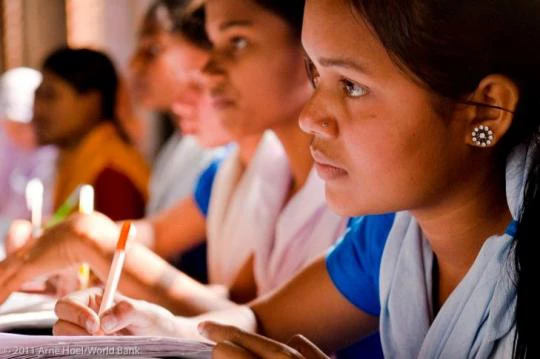In South Asia, a region where girls are now going to school in unprecedented numbers, Malala means many things to many people. To parents who send their daughters to school with difficulty, she validates a growing belief in power of girls’ education to liberate families from poverty. To schoolgirls in Pakistan, Afghanistan, Bangladesh, Bhutan, India, the Maldives, Sri Lanka and Nepal, she is an icon of victory and hope. And to governments and development partners, she represents the millions of girls who arrive in school every morning trusting that education will prepare them well for life, and also those so poor or disadvantaged that they do not enroll even at the primary level.
As we celebrate Malala’s joint acceptance of the Nobel Peace Prize together with Kailash Satyarthi, let’s take a quick look at South Asia’s progress on girls’ education. First, the net primary enrollment rate for all children in South Asia has risen rapidly from 75 percent in 2001 to 89 percent in 2010. The region has also made significant progress towards achieving gender parity in primary education, with the number of out-of-school girls falling 59 percent from 23 million in 1999 to 9.5 million in 2012. Bangladesh is a stellar example, with as many or more girls than boys now attending primary and secondary school and female literacy soaring from 65 percent to 83 percent, with the largest gains being in the age group 15 to 24. This has been thanks to smart education investments and effective cash transfer programs to encourage families to send their girls to school.
Within this overall picture of progress on enrollment, there are significant differences between and even within countries. Afghanistan, Pakistan, and geographical pockets in other countries still have a long way to go to equalize education opportunities for girls. Yet numbers don’t always tell you the whole story, and no country is a better example of this than Afghanistan. While the numbers look unimpressive at first glance—with roughly 8 million students in the public school system of whom 39 percent are girls—they hide the fact that there has really been a lot of progress despite some daunting challenges. As recently as 2001, there were only 2 million students enrolled, of whom less than 1 percent were girls. For me, it is always a treat to visit a school in Afghanistan and see young girls studying, playing and laughing – and reaffirms to me the importance of our work in supporting education around the world.
As we work towards getting disadvantaged children into school in South Asia, there are many lessons emerging from Afghanistan in terms of what works to both enroll and retain girls in school. The most important one is that it takes a combination of factors to do this—location of schools close to communities, secure boundary walls, female teachers in higher grades, toilets for girls, incentives such as stipends or food transfers, and public information campaigns. To succeed, enrollment strategies, particularly in challenging settings, need to be holistic and cross-sectoral, bringing in a wide range of expertise from education to infrastructure to social protection.
To return to what Malala stands for—globally, and not just in South Asia—girls’ education does not end with getting girls into school, although that is an obvious first step. It means providing them, and indeed all children, an opportunity to acquire real learning while they are there. And when it comes to real learning, the literacy and numeracy acquired in a classroom, South Asia does not shine. We estimate that a quarter to a third of all students completing primary school in the region lack basic literacy and numeracy, which hamstrings their subsequent learning and nature of employment. These basic skills are needed not only to get formal sector wage jobs, but also to help increase the productivity of those running small farms or small businesses in the informal sector. There are also broad gains to families and societies from women being literate and numerate even if they do not go out to work.
A recent World Bank Group report, Student Learning in South Asia: Challenges, Opportunities, and Policy Priorities emphasizes education policy needs to change to deliver improved educational outcomes. Public investment in education cannot be limited to constructing classrooms and hiring teachers. There are a number of policy priorities that will raise the level of learning in South Asia, including ensuring good nutrition for young children from poor families, focusing on the effectiveness and accountability of teachers, using public financing as an incentive for stronger performance, and conducting regular assessments of student learning outcomes, to name some of the most important areas.
Raising the level of learning and the quality of education services delivered in schools is the next big challenge not only for countries in South Asia, but also in many parts of the developing world. This is at the front and center of our education support to countries as diverse as India, Tanzania, Indonesia and Mexico. Malala is a global ambassador for what all children, including girls, dream of achieving, and their goals must be our goals as well. As we salute Malala today, we recognize that there is a long road still to be traversed…but at the same time we are confident that these dreams can be achieved.
Follow the World Bank Group Education team on Twitter @WBG_Education



Join the Conversation